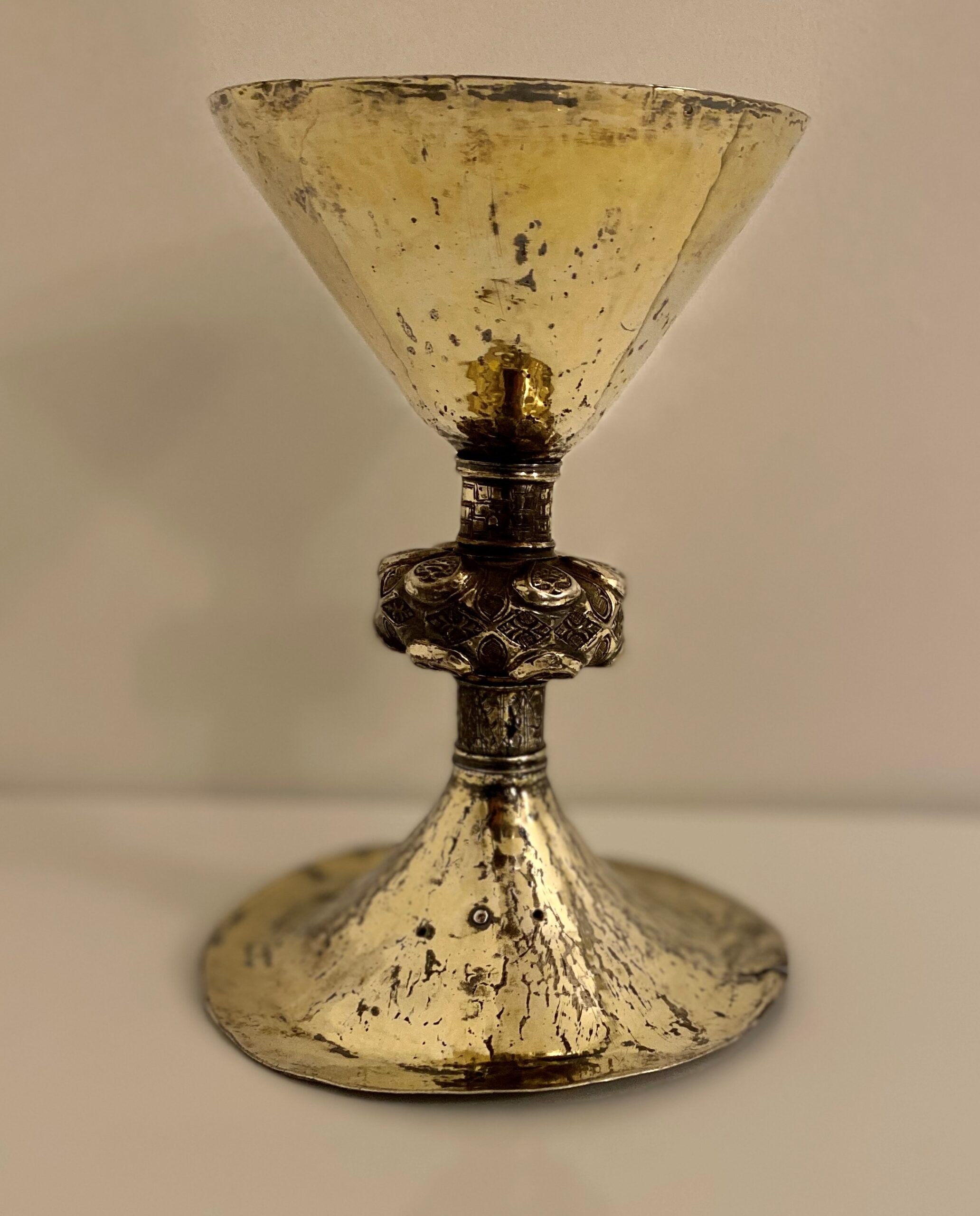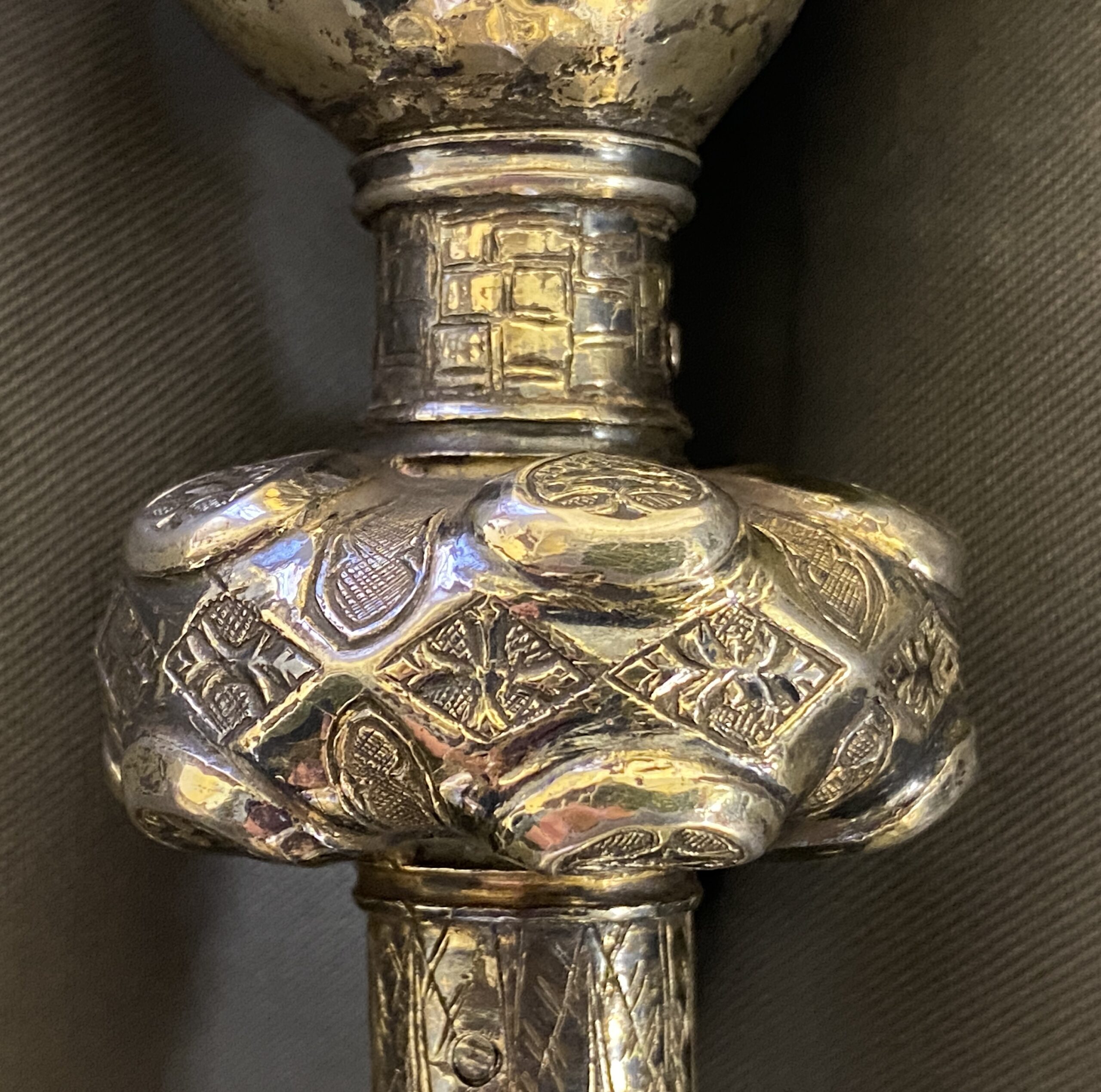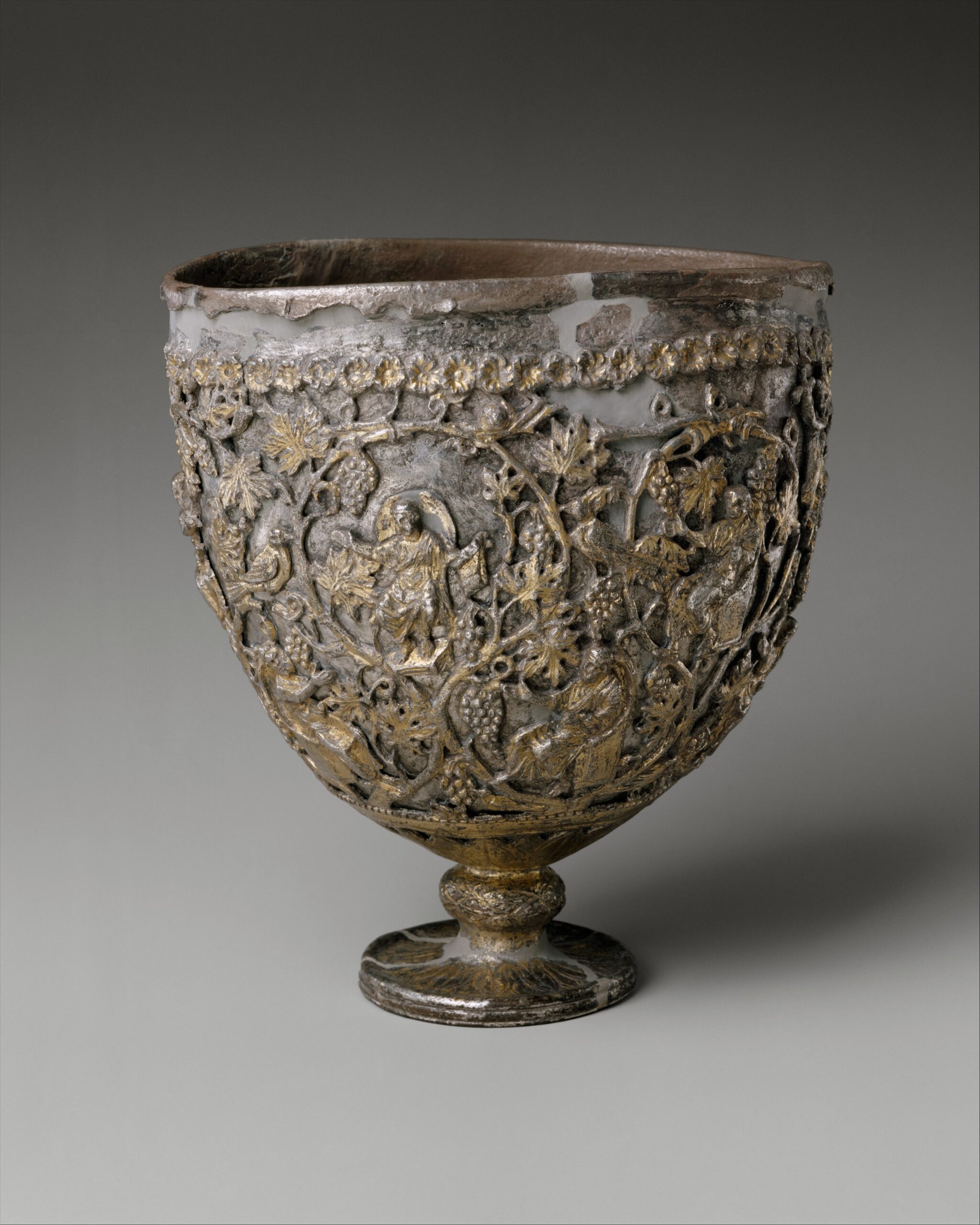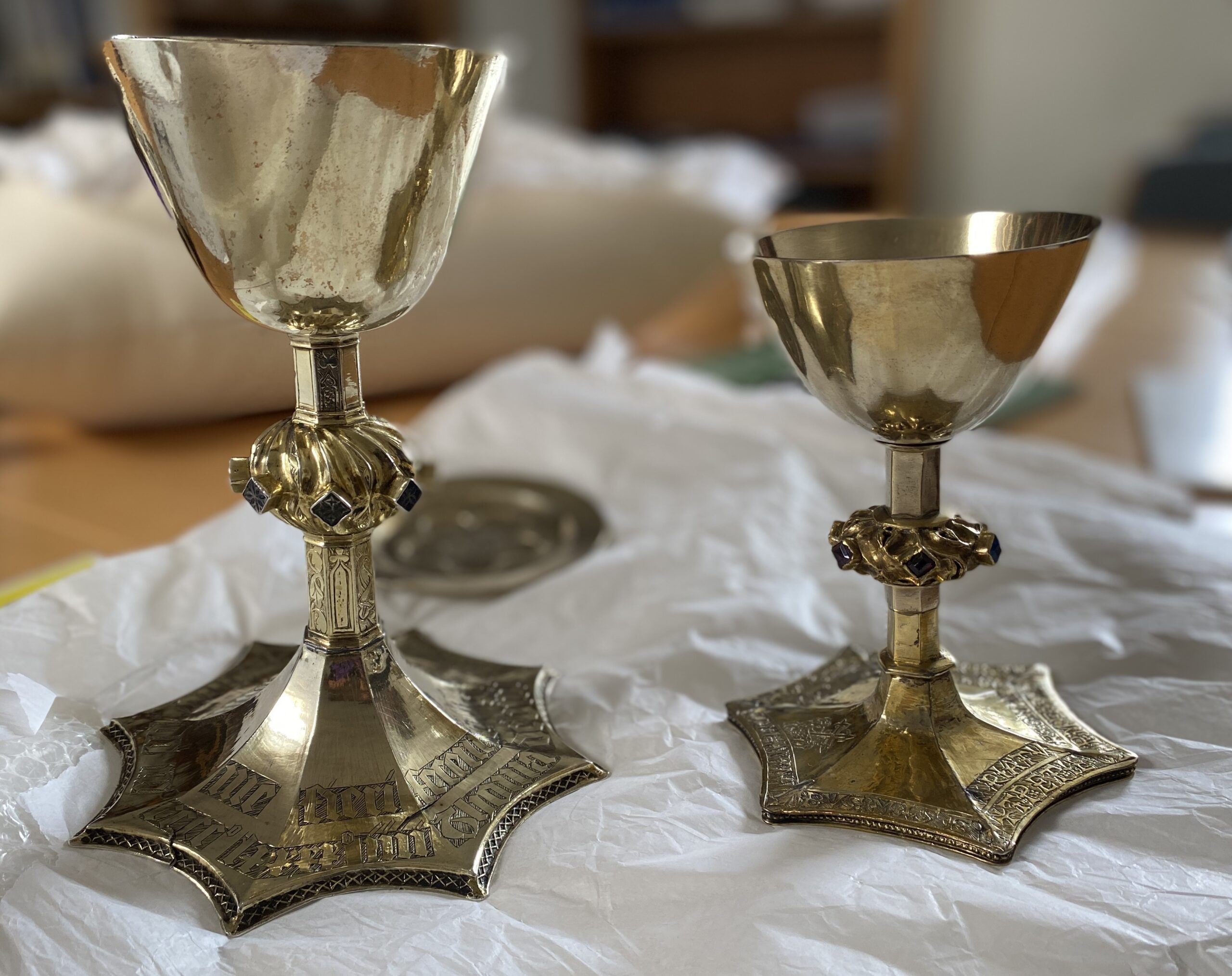By Małgorzata Krasnodębska-D’Aughton and Richard Keyes McDonnell
On 2 July 2021 a silver-gilt chalice was auctioned by Duke’s Auctioneers of Dorchester. The catalogue described the chalice as ‘an exceptionally rare Irish silver-gilt chalice, circa 1480’. Since its purchase, the chalice has featured in news articles and on television, particularly in the Catholic media in the United States, where it has also gone on exhibition and been used in Mass celebrations.

This is not the first time that a chalice associated with Ireland has attracted interest in the US. A chalice with confirmed provenance, dated to 1640 and commissioned, according to its inscription, by Daniel Swyne, priest of Lismore diocese, was donated to St Joseph’s Seminary in Yonkers, New York, in 1908 and has been the subject of much interest. Unlike the MacSweeny (Swyne) chalice, the chalice sold in 2021 bears no inscriptions and its provenance is unclear but, like the MacSweeny chalice, it has been displayed as an example of pre-Reformation Irish altar plate. Indeed, the name given to the chalice by its current owner, the ‘Ó Learghusa chalice’, reflects an Ireland-linked story invested in the object.
THE POWER OF PROVENANCE
Historians, especially those working with material culture, are cognisant of how historical objects become imbued with meaning by being connected to significant persons, transformative events or important places, and how objects’ social and cultural values, which go beyond yet often hand in hand with their financial value, are shaped by symbolic meanings projected onto them. In his famous study The elementary forms of religious life, published over a century ago, the French sociologist Émile Durkheim (1858–1917) discussed religion as a social phenomenon, noting that ‘when a thing is the object of prevailing opinion, […] it is felt even by those who do not submit to it’. As he remarked, symbolic objects, totems and sacred matter receive their ‘intensity’ from the social collective rather than from an individual or from the objects themselves.
Such was the case with the MacSweeny chalice, used as recently as three years ago to celebrate St Patrick’s Day Mass in New York’s St Patrick’s Cathedral. The 10 March 2021 edition of Catholic New York described it as a symbol of ‘the days of the Penal Laws in Ireland when the Catholic faith was outlawed and priests were hunted men’. At the turn of the nineteenth century, the chalice certainly became associated with the four MacSweeny priests who served in New York, as declared by the later inscription, and who probably worked among the Irish community. Since historic objects possess an inherent ability to telescope time, the MacSweeny chalice combined St Patrick’s mission to the Irish with the persecution of Irish Catholicism and nineteenth-century Irish immigration and thus became a carrier of multiple stories, with its meaning intensified through public rituals.

In a manner not dissimilar to Durkheim’s view of sacred objects as creations of societal mechanisms, cultural branding theories consider brands as ‘socially constructed thanks to a complex value-added system of intermediaries’. Thus objects may be branded by being associated with a particular country, which evokes that country’s popular representation and reputation and holds a potential to valorise an object. In the case of the chalice discussed here, its association with Ireland and the assumed date have placed the object in the story-line of persecuted Irish Catholicism.
CHALICES AND COLLECTORS
As far as the chalice’s story is concerned, the only tangible evidence involves its modern ownership by Wilson Rae-Scott, the grandfather of its seller. Wilson was born in Liverpool in 1889. By 1911 he was working in the moneylending business in Sheffield and then in London, where he became a company director of B.S. Lyle Ltd. With his wife and children, he lived at various addresses in London before settling at Longmeadow, a notable property along the Thames, by 1939. He died in 1968. It is not clear when or how he acquired the chalice, whether at auction, through a private dealer or even through repossession, given his role in moneylending.
Chalices were certainly of interest to antiquarians in the early twentieth century, the likely time when the chalice came into Rae-Scott’s possession. He may have read a book by Revd Samuel Gentle-Cackett, published in London in 1935, on the ‘Antioch Cup’. Found near Antioch in 1910, the cup was sold to a Paris-based art dealer and was soon identified as the Holy Chalice, the cup used by Christ during the Last Supper. Decades later, research proved that the so-called ‘Holy Grail’ was most likely a Byzantine lamp from the sixth century. [see below] In Ireland, a prominent Cork antiquarian, Robert Day, collected several chalices. When his collection was auctioned in 1915, the catalogue, listing over 1,400 lots, contained two photographs that displayed seven chalices from his collection.

As seen in the Day catalogue, it was not customary for all auction objects to be photographed, nor were they always extensively described. In addition, regarding the manner of cataloguing, the Victoria and Albert Museum acknowledges that its existing descriptions and provenance details have been ‘compiled over the life of the museum’ and may ‘reflect outdated ideas, practice, and analysis’. Such factors have proven a challenge in finding any traces of the chalice obtained by Rae-Scott in auction catalogues, given its lack of inscriptions, hallmarks or unusual iconographic details.
STARTING WITH AN OBJECT
What information can be obtained from the object itself? Chalices often declare, through the Latin phrase me fieri fecit/fecerunt, the names of those who ‘caused [them] to be made’; they speak of their patrons, the place for which they were made and the year of their making. This chalice is, however, silent in that respect. Yet the analysis of the object tells something of its story, revealing that it was made by a silversmith who used techniques consistent with medieval practices as well as the late medieval repertoire of designs; it then suffered some trauma, which resulted in its dismemberment and subsequent repair, and its replacement parts got further damaged and fractured.
The chalice is small and simple, with its most ornate and possibly the oldest section being a stem with an elaborate knop. Around the middle of the knop are twelve lozenge shapes filled with intersecting plant-like motifs; significantly, one lozenge bears the sign of the cross. Above and below the lozenges are twelve lobes with a leaf design, and between the lobes there are elongated shapes that resemble Gothic lancet windows. Both lozenges and lancet window designs represent the international vocabulary of late medieval motifs found on liturgical objects. They appear on chalices that were crafted across continental Europe and in pre-Reformation England.
They also feature on Irish chalices, as seen on the 1494 de Burgo–O’Malley chalice, now in the National Museum of Ireland, which has a knop with eight projecting lozenges and window designs on the stem. [see below] The upper stem of the chalice displays brick-like engraving, which finds some counterparts in Continental chalices such as a late fifteenth-century German chalice, now in the British Museum (AF.3044), which exhibits a similar design on its stem. The prominent zigzag motif on the lower part of the stem resembles the design on the stem of a Gothic chalice, dated to the fourteenth century, now in the collections of the Historical Museum of the Palatinate, Speyer (HM_0_01054).
A physical analysis of the chalice suggests that its current bowl and foot were not part of the original chalice, an observation confirmed by XRF (X-ray fluorescence) analysis—the artefact is indeed a composite object with a complex biography. The reasons for the replacement of these parts are not known; most likely they got damaged, intentionally or not. The replacement bowl is wide and conical, and the replacement foot is circular with a flattened rim. To stress the sacredness of the refurbished chalice, its re-maker attached to the chalice’s foot a figure of Christ crucified or the cross. This iconographic element found on other late medieval chalices is now missing; only three small holes and one remaining rivet suggest its place.

TECHNICAL ANALYSIS AND COLLABORATION
For over a year, starting in late 2022, the chalice became the subject of technical analyses. Dr Veronica Biolcati, Anna Hoffman and Professor Pádraig Ó Macháin of the Inks and Skins project, involving UCC’s Department of Modern Irish and the Tyndall National Institute, conducted an XRF investigation of the chalice to examine its metal composition. With the assistance of Dr Edith Andrees and Dr Paul Mullarky at the National Museum of Ireland, the chalice was analysed alongside two chalices of a confirmed Irish provenance housed in the Museum—the 1494 de Burgo–O’Malley chalice and the 1589 TP-IEP chalice.
The aim of the XRF analysis was to determine the metal composition in respective parts of the chalice, namely the bowl, the foot and the knop, which in turn could shed some light on the production process and the story of the artefact. The examination revealed that the chalice was crafted using a copper–silver alloy as base metal, with a gold layer applied through fire-gilding. In this process, commonly encountered in medieval silverware, including the de Burgo–O’Malley chalice, a gold amalgam was heated to evaporate mercury and leave a thin layer of gold.
The metal alloy of the knop and the foot showed trace amounts of lead, indicating either the medieval technique of cupellation used to extract silver or the addition of lead to improve copper’s workability. Lead was absent in the bowl, however, suggesting that the raw materials used to produce the bowl differed from those used in the making of the knop and the foot. In addition, a microscopic examination revealed imperfections in the gilding layer of the bowl and the foot which are less observable in the knop. These findings support the idea that the chalice is a composite object, crafted through different manufacturing techniques, and hint at different times of execution. The TP-IEP chalice also had its base and bowl refurbished, and these sections were manufactured from a ternary silver–copper–gold alloy, while its decorative coloured glass possibly dates from the seventeenth century. These discoveries shed important light on the reuse and refurbishment of medieval liturgical objects and unveil their complex lives.
As part of the investigation, the UCC Library’s Digital Scholarship Studio undertook a 3D scanning of the chalice using the EinScan HX hand-held scanner. The scanning process, led by Stephanie Chen and Martin O’Driscoll. presented specific challenges owing to the material properties and surface characteristics, mainly the highly reflective nature of the metal. Overall, the multi-disciplinary and multi-pronged approach to the chalice placed it at the centre of investigations and attempted to build its story from the object itself.
The chalice has had quite a journey from its original execution to its subsequent damage and refurbishment, from being a liturgical object to becoming an auction item, an object of academic investigation and an exhibition item. Like so many other liturgical objects that managed to survive the vagaries of time, its full story remains a mystery. It was conceived as a sacred vessel for the Eucharistic wine: the twelve lozenges and the twelve lobes on its knop evoke the number of the Apostles who were present at the Last Supper, and the centrally positioned cross on the knop alludes to the Crucifixion. The chalice has also become a vessel of history, telling stories of a shared European artistic heritage and the precarious survival of liturgical objects.
Małgorzata Krasnodębska-D’Aughton is a Senior Lecturer in History at University College Cork; Richard Keyes McDonnell is an archives assistant at the Cork LGBT Archive.
Further reading
L. Badia, ‘Theorizing the social: Émile Durkheim’s theory of force and energy’, Cultural Studies 30 (6) (2016), 969–1000.
V.Biolcati, A. Hoffman, D.Iacopino, R. Keyes McDonnell, M.Krasnodębska‑D’Aughton& P. Ó Macháin, ‘X‑ray fluorescence analysis of three late medieval silver chalices associated with Ireland’, Heritage Science 12 (2024) (https://doi.org/10.1186/s40494-024-01240-2).
M.Krasnodębska‑D’Aughton, ‘Me fieri fecit: Franciscan chalices 1600–1650’, in R. Ó Floinn (ed.), Franciscan faith: sacred art in Ireland, AD 1600–1750 (Dublin, 2011), 71–81.
K.Oosterlinck& A.-S.Radermecker, ‘“The Master of …”: creating names for art history and the art market’, Journal of Cultural Economics 43 (1) (2019), 57–95.
